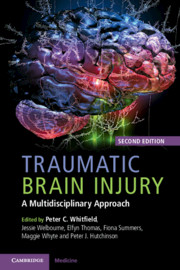Book contents
- Traumatic Brain Injury
- Traumatic Brain Injury
- Copyright page
- Contents
- Contributors
- Foreword to First Edition
- Foreword to Second Edition
- Chapter 1 Epidemiology of Head Injury
- Chapter 2 The Neuropathology of Traumatic Brain Injury
- Chapter 3 Experimental Models of Traumatic Brain Injury
- Chapter 4 Clinical Assessment of the Head-Injured Patient
- Chapter 5 Neuroimaging in Trauma
- Chapter 6 Scoring Systems for Trauma and Head Injury
- Chapter 7 Early Phase Care of Patients with Mild and Minor Head Injury
- Chapter 8 Early Phase Care of Patients with Moderate and Severe Head Injury
- Chapter 9 Interhospital Transfer of Brain-Injured Patients
- Chapter 10 Principles of Head Injury Intensive Care Management
- Chapter 11 Intracranial Pressure Monitoring in Head Injury
- Chapter 12 Multimodality Monitoring in Head Injury
- Chapter 13 Therapeutic Options in Neurocritical Care
- Chapter 14 Therapeutic Options in Neurocritical Care
- Chapter 15 Brain Stem Death and Organ Donation
- Chapter 16 Anaesthesia for Emergency Neurosurgery
- Chapter 17 Surgical Issues in the Management of Head-Injured Patients
- Chapter 18 Craniofacial Trauma
- Chapter 19 Cranioplasty after Head Injury
- Chapter 20 Neurosurgical Complications of Head Injury
- Chapter 21 Paediatric Head Injury Management
- Chapter 22 Assessment of Cognition and Capacity
- Chapter 23 Families
- Chapter 24 Principles of Rehabilitation
- Chapter 25 MDT and Rehabilitation of Head Injury
- Chapter 26 Neuropsychological Rehabilitation
- Chapter 27 Assistive Technology and Rehabilitation
- Chapter 28 Outcomes and Prognosis
- Chapter 29 Medicolegal Aspects of Traumatic Brain and Cervical Spine Injury
- Index
- References
Chapter 20 - Neurosurgical Complications of Head Injury
Published online by Cambridge University Press: 28 April 2020
- Traumatic Brain Injury
- Traumatic Brain Injury
- Copyright page
- Contents
- Contributors
- Foreword to First Edition
- Foreword to Second Edition
- Chapter 1 Epidemiology of Head Injury
- Chapter 2 The Neuropathology of Traumatic Brain Injury
- Chapter 3 Experimental Models of Traumatic Brain Injury
- Chapter 4 Clinical Assessment of the Head-Injured Patient
- Chapter 5 Neuroimaging in Trauma
- Chapter 6 Scoring Systems for Trauma and Head Injury
- Chapter 7 Early Phase Care of Patients with Mild and Minor Head Injury
- Chapter 8 Early Phase Care of Patients with Moderate and Severe Head Injury
- Chapter 9 Interhospital Transfer of Brain-Injured Patients
- Chapter 10 Principles of Head Injury Intensive Care Management
- Chapter 11 Intracranial Pressure Monitoring in Head Injury
- Chapter 12 Multimodality Monitoring in Head Injury
- Chapter 13 Therapeutic Options in Neurocritical Care
- Chapter 14 Therapeutic Options in Neurocritical Care
- Chapter 15 Brain Stem Death and Organ Donation
- Chapter 16 Anaesthesia for Emergency Neurosurgery
- Chapter 17 Surgical Issues in the Management of Head-Injured Patients
- Chapter 18 Craniofacial Trauma
- Chapter 19 Cranioplasty after Head Injury
- Chapter 20 Neurosurgical Complications of Head Injury
- Chapter 21 Paediatric Head Injury Management
- Chapter 22 Assessment of Cognition and Capacity
- Chapter 23 Families
- Chapter 24 Principles of Rehabilitation
- Chapter 25 MDT and Rehabilitation of Head Injury
- Chapter 26 Neuropsychological Rehabilitation
- Chapter 27 Assistive Technology and Rehabilitation
- Chapter 28 Outcomes and Prognosis
- Chapter 29 Medicolegal Aspects of Traumatic Brain and Cervical Spine Injury
- Index
- References
Summary
A traumatic skull base fracture can breach the dura, leading to a communication, or fistula, from the intracranial cavity to the external environment. This leads to a risk of cerebrospinal fluid (CSF) leak in 10%–30% of patients, highest in fractures of the anterior cranial fossa.1 CSF can subsequently leak from the nose (rhinorrhoea) or ear (otorrhoea). Many CSF leaks will seal spontaneously within 1–2 weeks with conservative management, but if CSF leakage is prolonged, then operative repair of the fistula is needed (see Chapter 18 for details on CSF leak diagnosis and management).
- Type
- Chapter
- Information
- Traumatic Brain InjuryA Multidisciplinary Approach, pp. 247 - 257Publisher: Cambridge University PressPrint publication year: 2020

